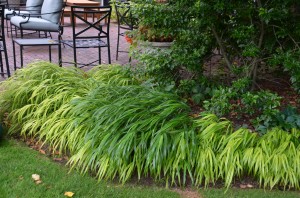Japanese Forest Grass (Hakonechloa macra) is the shade-loving grass utilized for accent – to brighten a dark patch in the garden (USDA hardiness zones 5-9). Forest grass grows best in a moist, compost-rich, well-drained soil. Soil moisture and light exposure a key factors to prevent foliage from scorching or discoloring. Too much or too little of either is never a good thing.
Partially shaded areas are preferred, but it can handle direct morning sunlight in (U.S. hardiness zones 5 and 6). Cultivars with variegated foliage are affected by the degree of sun exposure. In warmer climes gold hues may change to lime green.
Clumps of forest grass are rhizomatous and slow growers, particularly their first year after planting. Old foliage dies to the ground in late winter and new shoots emerge in mid-spring. Disease and pest problems are rare if environmental factors are proper.
‘Aureola’ is the most popular cultivar and was selected 2009 Perennial Plant of the Year by the Perennial Plant Association. It features golden variegated foliage, graceful arching habit, and an initial slow growth rate. It grows 14 to 18 inches high in a shady garden bed or mixed with other plants in containers. Grass blades take on a pinkish tinge in the cool autumn weather.
‘All Gold’ is similar to Aureola with ribbon-like gold leaf blades. All Gold is slightly a more vigorous grower and matures to 14 to 20 inches in height.
‘Fubuki’ exhibits white and green striping along the leaf blades, quite different than other forest grasses. Fall foliage takes on a pinkish tinge. Fubuki appears to tolerate more sunlight and exhibits slightly better heat and drought tolerance. “Fubuki” means snowstorm in Japanese.
‘Naomi’ grows 10-14 inches tall with creamy white and yellow-green variegated foliage in the spring and turning purple-red in the fall. Its growth rate is more vigorous than other forest grasses.
‘Nicolas’ grows 10-14 inches tall with bright green summer foliage and turns deep red in the autumn.


 Posted in
Posted in 
